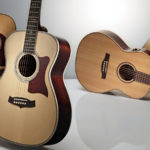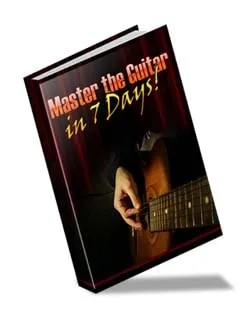If you are just starting out playing Celtic music on the guitar it can be difficult to pick up the rhythms. Folk guitarists often seem to have a kind of innate grasp of which patterns fit with which tunes.Â
Many musicians grow up with traditional music and have learnt to play along by ear and so often struggle to explain precisely what they are doing. The problem is confounded by the speed at which Celtic music is played. These factors can all add up to make Celtic guitar a difficult hobby for beginners to get a foothold in.
That’s where I come in!
I am Nye Farley from Finale Guitar in Sheffield, a full time teacher of Celtic, jazz, rock and blues guitar (you can find out more about me near the end of this article or on my website). In this blog I will be showing you the main rhythms used in the music of Ireland and Scotland, demonstrating how to recognise them and showing you the easy strumming patterns you’ll need in order to play along.
The text included is taken from my book Backing Guitar Techniques For Traditional Celtic Music, which teaches everything you need to create your own unique style of backing guitar for Celtic music and is available both as an ebook and in paperback (available on Amazon.com and Amazon.co.uk).
All the videos on this blog are taken from my Youtube channel Folk Friend. You can find loads more free Irish and Scottish guitar tutorials on there – I post a new one every Thursday! Subscribe to get all my free tutorials straight to your inbox.
Before we begin, I suggest that when learning any strumming pattern, you practice along with a metronome. If you do not have one you can find a good online alternative at metronomeonline.com.
Practice the patterns on a range of different chords, taking care to miss out any unneeded strings. For example you would miss out the bottom E string on an A chord or the E and A strings on a D chord.
One more thing- I am from the UK, so spellings such a “colour”, “recognise” etc are intentional!
Irish Rhythms
Jigs
A jig is a tune in 6/8. The easiest way to recognise them is that they go “diddley diddley diddley diddley diddley diddley diddley deeâ€. If you listen to the Kerfeunteun jig (also in the “Tunes†folder), you will hear that it goes “daa da diddly, diddley diddley, da da diddley, diddley deeeeee…â€.
If you count the syllables of “diddley diddley†you will arrive at the conclusion that there are six quavers (or 8th notes) in every bar. So another way to think of a jig would be “123456, 123456†etc. 6/8 is a “compound†time signature because the beats are weighted in blocks of three.
When you tap your foot along with a jig you will swiftly realise that, unless you are an extremely talented tap dancer, you will not be able to tap fast enough to beat out “123456†with your great clumpy toes. Instead your foot will tap twice per bar, on the 1 and the 4.
The most common way to back a jig is a strumming pattern which I call “diddly diddlyâ€. The player moves their hand on every quaver (123456 in every bar) in the following pattern:
| Quaver | 1 | 2 | 3 | 4 | 5 | 6 |
| Strum direction | ↓ | ↑ | ↓ | ↓ | ↑ | ↓ |
| Foot taps | TAP | – | – | TAP | – | – |
Personally I do not like this pattern – there are several reasons why. Number one is that for me it has never seemed at all intuitive – I prefer to always move my strumming hand on every quaver, alternating between up and down strokes.
That way I can just miss out the strings on some strokes to create the rhythm. In this pattern there are two down strokes on the adjacent third and fourth quavers meaning that an extra silent upward movement is required to get the hand back up between the two.
To me this seems difficult and not at all energy efficient. The rhythm is also not very clearly defined in this version. Despite these caveats it is the most common and often taught as “the traditional†method.
Vastly preferable to my ears is the “da-da-diddly†pattern:
| Quaver | 1 | 2 | 3 | 4 | 5 | 6 |
| Strum direction | ↓ Da- | ↑ (silent) | ↓ da- | ↑ didd- | ↓ le- | ↑ y |
| Foot taps | TAP | – | – | TAP | – | – |
Accentuate quavers one and four where you would naturally tap your feet. I like this pattern as it changes arm direction on every beat and so conserves their natural motion which will make it easier to keep in time. At least, that’s what I think – most people seem to plump for the first option so I suppose they can’t all be wrong.
There is a third way which I call “upside down strumming†or “diddley dakadaâ€. It is less traditional in sound, accentuating the off beats and adding a cool percussive element. I won’t outline it here but you can learn to play it in the video below:
Slip jigs
Slip jigs are tunes in 9/8. They are similar to jigs in that they are based around diddley diddleys, but dissimilar in that they have three diddleys per bar instead of two. Thus they go “Diddley diddley diddledum, diddley diddley diddledum, diddley diddley diddledum, diddley diddley daahhhâ€. This means that the rhythm is 123456789, 123456789 etc and you will tap your foot on the 1, 4 and 7. Note that unlike other types of tune they generally have sections of eight bars, instead of sixteen.
The easiest way to strum them is with a variant of the “traditional” jig strumming pattern outlined above, with an extra “diddley” (Down Up Down) added in each bar. I suggest that if using the above pattern you miss out the strum on the second quaver to add a clearer sense of where the bar begins.
This will give you “Dunk-da-diddley-diddleyâ€. As always put as much emphasis as you can on the dominant beats where the foot taps are – tapping your feet as you play will help you do this naturally and keep your arms in time.
| Quaver | 1 | 2 | 3 | 4 | 5 | 6 | 7 | 8 | 9 |
| Strum direct- ion | ↓ | . | ↓ | ↓ | ↑ | ↓ | ↓ | ↑ | ↓ |
| Foot taps | TAP | – | – | TAP | – | – | TAP | – | – |
Reels and hornpipes
Common in English folk music especially for morris dancing, hornpipes are in the time signature of 4/4 but are slower and more bouncy than reels. You will spot them easily because they end every phrase with a “pom POM!â€. Irish and Scottish hornpipes are also fairly common.
The Scottish ones will sometimes contain the Scotch snap rhythm mentioned above- again this does not affect the rhythm guitarist. You can back them using the “Bum-chumpf-bumpa-chumpa” reel pattern mentioned below- you will just need to play a slower and more swung version to accompany a hornpipe.
A reel is a tune in 4/4. This means that it has four beats in every bar, each being one crotchet (UK) or quarter beat (USA, Canada etc). A reel is easy to discern because when you hear one you will tap your foot to the pulse “1 2 3 4, 1 2 3 4 etcâ€. The tapping of the feet (or at least a foot!) is VITAL for being a good backing guitarist – it will coordinate your strumming and act as your internal metronome.Â
When tapping along with a reel played at normal session speed you will be tapping on beats 1 and 3. They go so fast that to tap on 1, 2, 3 and 4 would wear out your poor feet!Â
The most obvious way to back a reel is the “bum-chumpf†method. This can progress with some minor variation to “bum-chumpf-bumpa-chumpaâ€. These are popular methods because Celtic traditional music can be very fast and this pattern doesn’t require too complicated a movement to sound good. It has an open, ringing sound as it doesn’t contain any palm muting. The “silent” quavers are ones on which your hand moves back up to its starting position but without hitting the strings.
| Quaver | 1 | 2 | 3 | 4 | 5 | 6 | 7 | 8 |
| Strum direction | ↓ Bum | ↑ (silent) | ↓ Chumpf | ↑ (silent) | ↓ Bum- | ↑ pa- | ↓ chum- | ↑ pa |
| Foot taps | TAP | – | – | – | TAP | – | – | – |
Start with just “bum-chumpf bum-chumpf bum-chumpf bum-chumpf†(aka quavers 1-4 repeated ad infinitum) and you should gradually find that you start adding the extra little strokes ( aka the “pasâ€) naturally.
For this method you should try to hit only the root note (or at least the lowest pitched two or three notes) of your chord for the “bumsâ€Â and the rest of the strings for the “chumpfsâ€.
Swing
One thing to bear in mind with reels and hornpipes is that different players will play them with more or less “swing†and this will affect how you can back them.Â
Here’s a demonstration – try saying the following phrases out loud and then humming a reel you know with them to show how it would sound swung or straight.
Straight
Ticker tacker ticker tacker ticker tacker ticker tacker …
SwungÂ
A tick a tack a tick a tack a tick a tack a tick a tack …
Hopefully in the first example your tune should have had evenly spaced quavers like this:
I . . . I . . . I . . . I . . . I . . . I . . . I . . . I . . .¦
And in the second you should have had a groovy shuffle like this:
I . . . . . I . I . . . . . I . I . . . . . I . I . . . . . I . ¦
Different melody-players will play different tunes with different amounts of swing so try and imitate their swing (or lack thereof) in your backing. There is also a great deal of variation in regional styles of melody playing.
Strathspeys
These are a tune type found uniquely in Scottish traditional music. Scottish and Irish folk music have a lot in common, but Scottish folk music is differentiated by the “Scotch snap”, a syncopated rhythm in which a crotchet is divided into a semi-quaver followed by a dotted quaver. This has a very noticeable effect on the melody’s rhythm (which is interestingly also found in some of the folk music of Eastern Europe, but nowhere else within the Celtic tradition). However, I have good news for the guitarist: you can play along with a strathspey exactly as if it were a slow reel!
There are several other less common time signatures, notably…Â
Waltzes
Waltzes have three crotchets in each bar and thus go 1 2 3, 1 2 3, 1 2 3, 1 2 3. They are not really a “Celtic” rhythm but have been absorbed into UK trad over the years from European neighbours and courtly dancing. I usually tap my foot on beats 1 and 3. I find the easiest way to strum along with a waltz is to play the root note of the current chord on the dominant 1 beat in each bar, and then strum the rest of the strings on beats 2 and 3.
Polkas
A polka is in 2/4. Instead of going 1 2 3 4, 1 2 3 4 like a reel, it goes 1 2, 1 2, 1 2, 1 2. This makes them seem much more hoppy (or in my case stumbly) and they are also considerably faster making them harder to keep up with for the backing guitarist. You can back them using a VERY fast and very straight version of the reel pattern shown above. I usually leave out the up strokes for polkas due to their speed.
Slides
Slides sound very much like jigs but are sometimes, though not always, written down in 12/8. The thing which makes them clearly different from a jig is the accenting of the notes, which is much heavier on the main beats (quavers 1 and 4) than it would be in a jig and almost non-existent on the other quavers. They are also generally played faster than jigs. For the backing guitarist a slide is played with the same patterns as a jig but with the accents exaggerated to match the feel of the melody.Â
Want to learn more?
You can find loads more free guitar resources (tabs, Celtic guitar lessons, videos, chord diagrams, music theory etc) on my blog, available here.
If you’d like to learn how to play by ear, jam along with tunes, learn new songs, understand music theory, improve your rhythm playing, use jazzier chords or anything else to do with Celtic backing guitar then there’s really no substitute for learning from an experienced professional teacher.Â
Contact me NOW to book a 1-on-1 guitar lesson via Skype, Zoom or Whatsapp!
Alternatively call 07722088131 or email info@finaleguitar.co.uk .
About me
 I am a Celtic, jazz, rock and blues guitar teacher based in Sheffield.
I am a Celtic, jazz, rock and blues guitar teacher based in Sheffield. I have been teaching for the past 8 years and now teach students from all over the world via Zoom, Skype and Whatsapp. I grew up playing Irish music thanks to my mother who lived in Ireland for many years and came back to Wales with a bag of tin whistles and a fiddle, bringing her love of Irish music along and passing it down to me.
In order to pass the torch on to others, I run the Folk Friend Youtube channel where I post weekly Celtic guitar lessons covering strumming patterns, chord options, ear training, DADGAD, music theory and much much more. It’s all free- I fund it through sales of my books and the various products and practice aids I have invented over the last few years.




 Sign up to receive a free ebook: Master The Guitar in 7 days! (available for a limited period)
Sign up to receive a free ebook: Master The Guitar in 7 days! (available for a limited period)